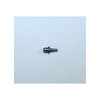Here is the pistol:

The issue is sometimes the firing pin protrudes from the recoil shield after the hammer comes forward. It can take significant force to 'push' it back in. As in sometimes I can't push it back in with my finger as it hurts too much and it takes a blow with a plastic hammer. Sometimes it gets 'wedged' pretty good.
Here are the parts involved:

I have been successful in removing the firing pin bushing. The spring was a little weak and I made a new one with a little more 'force'. Here are some detailed pictures of the actual pieces from the actual pistol:


As you can see, the firing pin has a bevel on the bottom. I'm surmising that the bevel is catching on the inside edge of the bushing as the bushing necks down to the diameter of the firing pin. Here is a close up of the bevel on the firing pin.

About halfway up the bevel you can see some deformations that I think is the point where the firing pin 'wedges' into the bushing.
Now there was one other observation. I chucked up the firing pin into the drill and there was a slight bend in it. That too could cause the bind/wedge. I did tap it lightly and lo and behold it did straighten almost straight.
I have polished every surface on both the firing pin and the bushing with polishing compound in the hopes it would be 'slippery' enough to not catch/wedge. I very lightly used a tapered round file to try to soften the edges inside the bushing where the tapered part of the firing pin contacts the bushing.
I'm open for suggestions. Although the polishing/straightening did improve the situation, it does still bind/wedge sometimes though not as hard as before the polishing. The parts have close to 130 years of wear on them, so I don't think there is any circumstance where filing or sanding will improve the problem. Note that even though there is 130 years of wear on the parts, the tip of the firing pin looks to be in the same shape as the day it was manufacturered.

The issue is sometimes the firing pin protrudes from the recoil shield after the hammer comes forward. It can take significant force to 'push' it back in. As in sometimes I can't push it back in with my finger as it hurts too much and it takes a blow with a plastic hammer. Sometimes it gets 'wedged' pretty good.
Here are the parts involved:

I have been successful in removing the firing pin bushing. The spring was a little weak and I made a new one with a little more 'force'. Here are some detailed pictures of the actual pieces from the actual pistol:


As you can see, the firing pin has a bevel on the bottom. I'm surmising that the bevel is catching on the inside edge of the bushing as the bushing necks down to the diameter of the firing pin. Here is a close up of the bevel on the firing pin.

About halfway up the bevel you can see some deformations that I think is the point where the firing pin 'wedges' into the bushing.
Now there was one other observation. I chucked up the firing pin into the drill and there was a slight bend in it. That too could cause the bind/wedge. I did tap it lightly and lo and behold it did straighten almost straight.
I have polished every surface on both the firing pin and the bushing with polishing compound in the hopes it would be 'slippery' enough to not catch/wedge. I very lightly used a tapered round file to try to soften the edges inside the bushing where the tapered part of the firing pin contacts the bushing.
I'm open for suggestions. Although the polishing/straightening did improve the situation, it does still bind/wedge sometimes though not as hard as before the polishing. The parts have close to 130 years of wear on them, so I don't think there is any circumstance where filing or sanding will improve the problem. Note that even though there is 130 years of wear on the parts, the tip of the firing pin looks to be in the same shape as the day it was manufacturered.
Last edited:




